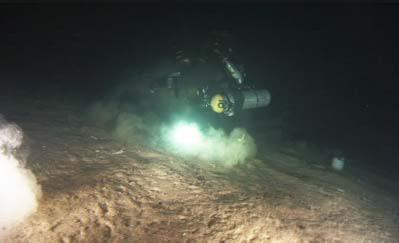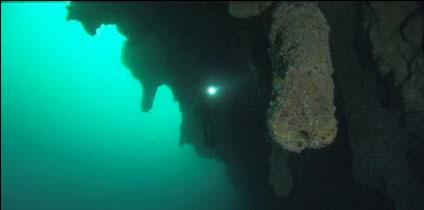|
Belize has become one of the premiere diving destinations in the world, and topping the list of dive sites is the magnificent Blue Hole. While thousands of divers have explored the walls and crevices of this mysterious formation, not one had documented reaching the bottom, until now.
A team of expert deepsea
divers took the challenge
to explore the extreme
depths while documenting
the adventure on
high-definition video for a
new DVD, Dive Portal
Video Magazine. John
Chatterton and Richie
Kohler are the stars of the
popular History Channel
television show, Deep Sea
Detectives. They have diverted
slightly from exploring
the galleys of long
sunk shipwrecks to explore
the natural formation of the famous Blue Hole.
Accompanying the divers is underwater videographer,
Evan Kovacs, who will be responsible for documenting
the underwater adventure.
The challenge and appeal, according to the team, is that it had never been done before. Some rumors exist of divers reaching the bottom, and it is thought that the famous ocean explorer Jacque Cousteau had used a mini-submarine to explore the Hole’s depths. But, no documentation has surfaced.
Early Thursday morning under stormy skies, the
team headed for the Blue Hole, about 60 miles from
Belize City. The almost perfectly circular Blue Hole
is more than 1,000 feet across with an unknown depth,
but estimated around 400 feet deep.
The hole is the opening to what was a dry cave system during the Ice Age. When the ice melted and the sea level rose, the caves were flooded, creating what is now an attraction for thrill seeking divers. Today, the Blue Hole is famed for its sponges, barracuda, corals, angelfish—and a school of sharks often seen patrolling the hole’s edge. Once the Deep Sea Detectives entered the water, they quickly left their recreational diving counterparts near the relative surface as they descended to three hundred feet below the surface where Kohler remained while serving his role as deep-water support. Finally, as the depth gage read 365 feet, the team of Chatterton and Kovak gently touched down on the silty bottom. The team had twenty minutes to explore the bottom using a highly advanced rebreather apparatus. This apparatus efficiently recycles exhaled air that consists of a combination of oxygen and helium that the divers use to breathe. “It looked like vast sand dunes, it’s rolling and uneven,” explained Chatterton. Kovacs noticed some crabs and other creatures that were dead, but because of the lack of oxygen at that depth, were not decomposing and could be a number of years old.
After their brief 20-minute exploration, the team started their long slow ascent to the surface. While decompressing for nearly two and a half hours, they were able to enjoy much of the area that attracts so many divers to the Blue Hole. The footage captured during their expedition will be part of a new DVD magazine titled Dive Portal Video Magazine where Chatterton and Kohler will portray a variety of challenging and extraordinary dives. The DVD should be available in April 2006. 
For more information, follow these links: Blue Hole Origin and Sea Level Change Diving in Belize and Ambergris Caye Ambergris Caye Barrier Reef Map and info on Ambergris Caye Dive Sites
 Copyright byCasado Internet Group |




